27 Jul (Wed): Discussion on "The Seacil Artificial Reef" hosted by the Nature Society (Singapore)
 July 7, 2011
July 7, 2011
The Seacil Artificial Reef project aims to restore and preserve corals at Sentosa and Labrador Park, says the Nature Society (Singapore) announcement.
 |
| A seacil being ‘launched’ at Sentosa, from an article on the project in Innovation, Vol 7 No. 1 |
The project was a source of controversy a few years back, the Society adds.
Nature Society (Singapore) hosts this discussion with Charles Rowe, the leader of this project, who will be giving a presentation on the merits of this project. Detractors of this project will also be invited to air their views and concerns. Join us in this discussion to judge for yourselves whether The Seacil Artificial Reef project was more of a boon or a bane to local coral conservation.
This discussion is open to the public.
Time: 8pm
Venue: The Sunflower (NSS office). 510 Geylang Road #02-05,Singapore 389466
Website: http://www.nss.org.sg/
Contact: email contact@nss.org.sg or call 6741 2036.
I hope to attend, and look forward to learning more about the project during the upcoming discussion.
What is the Seacil Project about?
from Artificial Reef Revitalises Marine Life by Kwang Wei Tjan and Lay Leng Tan in Innovation Vol 7 Issue 1, “the Seacil constitutes a concrete structure deliberately placed on the seabed to mimic the characteristics of a natural reef.”
“For waters with thick mud, the builders erect long, recycled plastic pipes on the seabed to support the Seacils. Divers first shift the structure to deeper waters using airbags and buckets, then lower it onto mud sub-sea surfaces (Figure 2). Cement weighs the structure down and anchors it to the upright pipes. High-pressure air pumped down through a hose flushes away the mud from the Seacil, thus allowing the establishment of marine life.”
 |
| from an article on the project in Innovation, Vol 7 No. 1 |
“Team members graft hard coral onto the platform and then introduce anemones and clown fish.”
 |
| from an article on the project in Innovation, Vol 7 No. 1 |
“Perhaps the greatest impact comes from the setting up of artificial reefs and rescue operations of marine life from areas designated for reclamation where the Seacil can serve as a planting or a transfer base. It can replace habitat loss elsewhere or in places where particular substrates are threatened, help preserve endangered sea life, even encourage new growth to revive many threatened underwater ecosystems everywhere.”
“The researchers’ future field surveys will focus on tagging the coral and monitoring the survivability of these underwater organisms.”
Diagrams in Undersea garden takes root S’pore Poly team creates marine site off Labrador for corals to regrow by Shobana Kesava Straits Times 29 Oct 07 outlines the structure of the seacils.
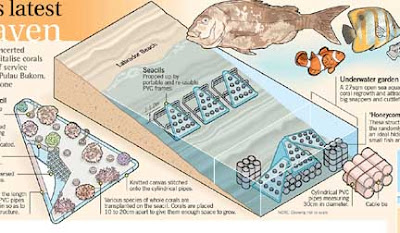
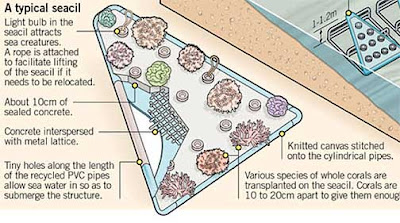
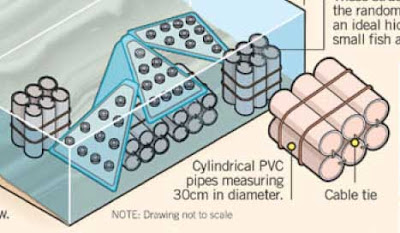
According to this undated online ppt by students of Singapore Polytechnic, they propose putting up seacils along West Coast beach, around the Southern Islands and at Sentosa lagoons.
What are some of the issues regarding the seacils?
Where do the grafted marine life come from?
from Artificial Reef Revitalises Marine Life, “Divers first harvested coral from the affected zones off Sentosa and Labrador. They selected healthy undamaged coral without bleached or dead areas and removed them carefully off the reef.”
How successful have the seacils been?
I am unable to find online results of monitoring of the project. Hopefully, these will be revealed during the discussion.
How will the project avoid damage to existing natural habitats during seacil construction, seacil launch and installation, and from debris resulting from seacil damage and ‘decay’ over time?
Since 2006, large concrete structures were seen on the seagrass meadows on Labrador.
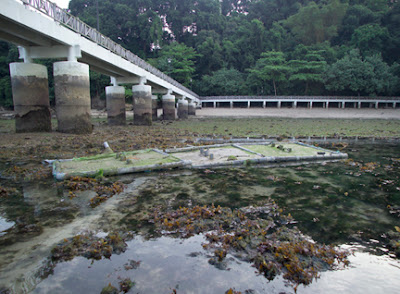 |
| From Large debris on Labrador explained? Oct 2007 |
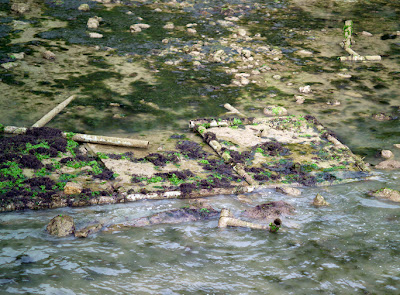 |
| From Large debris on Labrador explained? Oct 2007 |
Large loose plastic tubing and debris were seen on Labrador shore, abrading existing habitats including seagrasses and corals as they moved in the water.
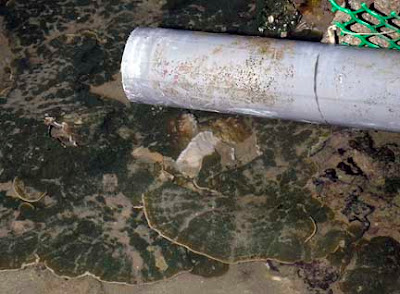 |
| From Large debris on Labrador explained? Oct 2007 |
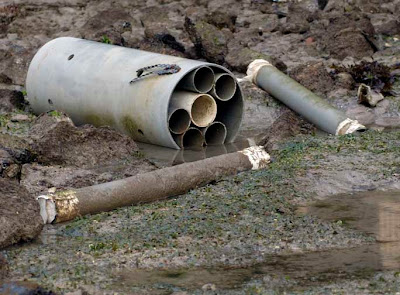 |
| From Large debris on Labrador explained? Oct 2007 |
In Nov 2007, the Straits Times reported that NParks said “The project is not harming the environment, since the artificial reef and garden sit on the sea floor, away from the natural coral reef zone of the nature reserve.” NParks added the debris “on the beach could have come loose and been washed ashore” and “that NParks had asked the SP team to remove them.”
In late Dec 2007, it seemed the large structures had been partially dismantled and lighter portions removed, although the concrete slabs remained on the shore (and began disintegrating). Portions of the concrete structure continued to be seen in Mar 2008 and Jun 2008 and Apr 2010
In Dec 2010, a triangular concrete slab was still seen on the high shore, from sgbeachbum.
seacil@labrador (HD) from SgBeachBum on Vimeo.
Other updates on Labrador
In Jun 2009, access to Labrador shore was permanently closed by NParks.
The natural seagrass meadows, reefs and coastal habitats on Labrador, our last mainland reef-rocky shore are bearing the brunt of the nearby long-term massive reclamation for a new Pasir Panjang Container Terminal which also includes underwater blasting.
My past interaction with Singapore Polytechnic on the issue in 2007:
On 30 Oct, I sent an email to Singapore Polytechnic Corp Comms informing them that I had posted photos of large debris on Labrador and asking two questions:
(a) Are the equipment depicted in my photos related to any projects by Singapore Polytechnic?
(b) What steps have been put in place to ensure that Cpt Francis’ project as outlined in the ST article does not result in damage to Labrador? (Undersea garden takes root S’pore Poly team creates marine site off Labrador for corals to regrow by Shobana Kesava Straits Times 29 Oct 07)
On 7 Nov, Singapore Polytechnic suggested a meeting to discuss the issue. I replied that I would only attend if I was not required to agree to non-disclosure of the meeting’s discussions.
On 21 Nov, when I asked about the meeting, I was informed that it was decided not to have the meeting and that the issues I raised had been addressed in the interview by Straits Times with Cpt Francis.
On 21 Nov, I also offered to give Singapore Polytechnic a free public talk about our shores to SP staff and students. I was informed that I would first have to submit my presentation materials for submission to SP management to review. I have offered them a CD of the entire presentation.
On 26 Nov, I also emailed Singapore Polytechnic about the issues mentioned in this blog entry.
I did not hear from Singapore Polytechnic about the 26 Nov email nor to my offer to give a talk about our shores to staff and students at Singapore Polytechnic.
Related articles
- Artificial Reef Revitalises Marine Life by Kwang Wei Tjan and Lay Leng Tan in Innovation Vol 7 Issue 1
- Seas get breath of new life in Riot, a magazine of Singapore Polytechnic
- Undersea garden takes root S’pore Poly team creates marine site off Labrador for corals to regrow by Shobana Kesava Straits Times 29 Oct 07
- Labrador Beach: Nature lovers fear coral project will cause damage But NParks says it is not true that artificial reef structures harm the environment Shobana Kesava, Straits Times 26 Nov 07;
Related blog posts
see also links on these posts for more blog posts on the issue
on wild shores of singapore
- Checking up on Labrador Apr 2010
on wildfilms
- Labrador Nature Reserve: after the construction Mar 2008
- Can Labrador Survive Dec 2007
- Labrador Nature Reserve: trashed Dec 2007
- Updates on large concrete slabs on Labrador shore Nov 2007
- Large debris on Labrador explained Oct 2007
This article was first published in WILD Shores of Singapore.

 Posted in
Posted in 



 content rss
content rss
COMMENTS